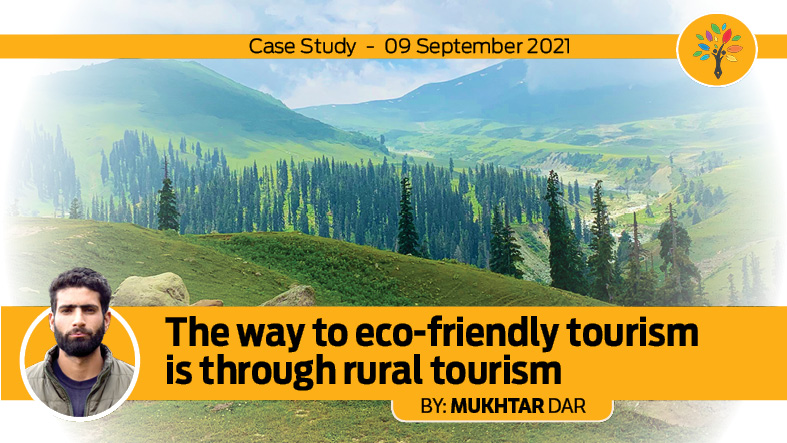By Mukhtar Dar
Introduction
Kashmir, famed for its breathtaking views, beautiful landscapes and magnificent lakes/water bodies, attracts tourists from all over the world. The tourism sector of Kashmir provides ample opportunities for employment generation and is a beacon of hope for around half a million people who are associated, directly or indirectly, with the sector. However, the booming non-eco-friendly tourism sector is having a serious and potentially damaging impact on the environment. The poorly managed sector has led to the depletion of natural resources and spoliation of tourist resorts.
Hazardous and non-eco-friendly tourism has become a threat to biodiversity and ecology. The central, as well as local government, should encourage the adoption of sustainable or eco-friendly rural tourism to tackle the constant environmental concerns and offer direct employment opportunities to rural populations in Kashmir.
What is eco-friendly rural tourism?
Rural tourism is an umbrella term that covers agri-tourism, ecotourism, and heritage tourism, unlike conventional tourism. The United Nations World Tourism Organization (UNWTO) defines rural tourism as “a type of tourism activity in which the visitor’s experience is related to a wide range of products generally linked to nature-based activities, agriculture, rural lifestyle/culture, angling and sightseeing”.
Rural tourism activities, according to the UNWTO, take place in non-urban (rural) areas with the following characteristics: i) low population density ii) landscape and land-use dominated by agriculture and forestry and iii) traditional social structure and lifestyle.
The Ministry of Tourism Government of India (2011) defines rural tourism as “any form of tourism that showcases the rural life, art, culture and heritage at rural locations, thereby benefiting the local community economically and socially as well as enabling interaction between the tourists and the locals for a more enriching tourism experience”. Thus, rural tourism provides a break from hectic and expeditious life enslaved by modern technologies and urban ways of living. Besides, it can be harnessed as a strategy for Rural Development.
In 2002’s National Tourism Policy, Rural Tourism was recognized as a focus area for employment generation and sustainable livelihoods. In the said policy, it was clearly mentioned that “Special thrust should be imparted to rural tourism and tourism in small settlements, where sizable assets of our culture and natural wealth exist.”
The first regions to adopt the concept of developing and promoting rural tourism were Rajasthan and Kerala. Pertinently, Kerala is one of the most famed eco destinations. For example, the Kumarakom Rural Tourism Project in Kerala has shown the country how to provide benefits to the local community while ensuring eco-friendly practices and care for nature. Under this project, the Kerala Tourism has made an agreement with Kudumbashree to sell fruits and vegetables, bought from the local community, to visitors in kiosks and supply them to hotels and restaurants. Kerala for this eco-friendly tourism model received the best award for rural tourism. Similarly, Rajasthan is setting an example for how to reduce the impact of tourism on the environment and help the ruler communities to earn their livelihood through sustainable means. There are several villages like Nimaj, Tordi, Nawalgarh etc where tourists assist the local communities to indulge in eco-friendly tourism. In these tourist villages, different projects were initiated with a motive to get the villagers involved in ecotourism projects, empower disadvantaged women of Rajasthan by helping them to learn skills and involving people in several causes that include afforestation and water resources conservation.
Non-eco-friendly tourism in Kashmir
The experts believe that the poorly managed tourism sector has left a negative impact on the environment in Kashmir. They fear that constant recklessness can result in a situation they call “tourism destroys tourism”. For instance, the data of Dal Lake tracked by the Centre for Science and Environment mentions that the Lake covered an area of 75 sq km in 1200 AD. By the 1980s, the area was reduced to 25 sq. km, and today it has drastically reduced to 12 sq. km. The depth has also reduced from 45 feet to 4 feet.
The “inability and lackadaisical attitude” of lakes and Water development authorities (LAWDA) in preserving the famed Dal lake raised questions about their sincerity and credibility. Reports claim that funds sanctioned for the maintenance and preservation of the lakes were not properly used. As per the reply submitted by the J&K government on September 18, 2018 to J&K high court, since 2002, 759 crores of rupees were spent on the preservation of the Dal Lake but the situation didn’t improve. Dr A Majeed Kak, who conducts extensive surveys on lakes of valley claimed that the unscientific method adopted by LAWDA to clean the lake has proved counterproductive.
Similarly, Wular which is one of Asia’s biggest freshwater lakes has also witnessed extensive degradation in recent decades as the concerned agencies have failed to stop the silting and encroachment. A case study conducted by Wetland International on famous Wular Lake found that during 1911-2008, the overall water spread and marsh areas shrunk by over half, reducing one-fifth of the area’s water storage capacity.
The preventive measures initiated by authorities to save these water bodies from getting depleted remain ineffective. If the situation of the aforementioned water bodies continues to worsen at the same galloping rate it has been in recent years, it will affect the tourism sector of Kashmir badly together with affecting the people’s livelihood.
If one looks at famous forest tourist destinations of Kashmir, the picture is not different. The Scroll reported in 2018, “How Kashmir’s famed tourist resorts are being turned into heavily polluted concrete Jungles.” While quoting the Center of Research for Development’s report of 2015, the Scroll wrote that in Sonamarg, “57.5 hectares of land has already been brought under the built-up area when the total area proposed to be under built-up by 2025 is about 60 hectares.” The report depicted that 96% of the built-up area had already been covered in 2015, even though the accommodation related construction, which was envisaged to get accommodated in the built-up area, is lagging far behind. This means there is no scope for further construction as it will damage the fragile ecosystem of the area, probably beyond repair. The report further said that 5.66 tonnes of solid waste is generated per day in Sonamarg and there is no proper waste management mechanism in place, resulting in the waste being dumped at multiple sites, and liquid waste from 46 hotels directly goes into the Sindh stream. The situation became far worse after 2018, the year when this report was published by the Scroll.
The devastating effect of the poorly managed tourism sector can be witnessed in the famous tourist resorts of Pahalgam and Gulmarg too. In Pahalgam, 1500 illegal structures have been installed in the forest and wildlife zones. The study titled “study on sustainable tourism in Kashmir” found that the number of tourists visiting Pahalgam in July 2015 was four times higher than the carrying capacity of the area and the destination is also facing a severe problem of waste management. Gulmarg, a world-famous tourism resort is witnessing similar ecological degradation. The increasing influx of people and unplanned construction is quite noticeable. Environmentalists are of opinion that illegal construction and inadequate waste disposal are demolishing the flora and fauna of Gulmarg.
In the last few decades, a few more places have come on the list of tourist destinations including Doodhpathri, Yusmarg and Bangus Valley, etc. Although the places have not witnessed any major concrete constructions, they are witnessing a huge rush of people, resulting in the accumulation of huge plastic and other solid waste. These environmentally fragile places need to be thrown up for tourists under proper environmental planning and consultation while taking into consideration their sustainability, carrying capacity and waste management.
Eco-friendly rural tourism in Kashmir
Climate change has necessitated the world governments to step up their well-informed and environmentally conscious and environmentally committed efforts towards the development and promotion of ecotourism, sustainable tourist destinations. It involves ensuring responsible travel to natural areas, conserving the environment, and improving the well-being of the local people. This applies to Jammu and Kashmir, too, home to an ecosystem rich in biodiversity.
Most of the famous tourist resorts in Kashmir are located in rural areas; however, the opportunity is not used by the government to shift from non-eco-friendly tourism to eco-friendly rural tourism. The policies drafted for the promotion of sustainable eco-friendly rural tourism have failed to yield any concrete results. The government drafts its tourism policy every year, but it has so far remained confined to paper only.
Factually, the tourism sector of J&K has not been developed, under proper planning and a vision. There are multiple agencies that are controlling and regulating the numerous lakes, tourism resorts, famed gardens. Different departments including the department of fisheries, the department of ecology, the department of wildlife, department of floriculture are exercising control over different tourist places. There is no single entity that can be held accountable for the protection of these destinations. The existence of different agencies only complicates the problem.
The Draft Tourism Policy demands to make tourist spots sustainable, dynamic, and improving livelihood opportunities for local people. This was stated by Director Tourism J&K, Dr. GN Ittoo, in an official statement.
“The administration believes J&K has a lot of scope in the rural tourism sector and the government requires to evaluate on the spot feasibility and tourism potential of these areas. The government maintained that the rural areas need to be selected as new sites of attraction for the tourists so that the rural people are benefited from the process of tourism. Rural tourism is one of the important options before us to strengthen the rural economy. The tourism department delved upon the officers that under rural tourism, villages to be decorated in such a way that would be eco friendly and tourist can be attracted from outside by showcasing the art and culture of the villages,” reads the statement.
However, the Tourism Department has made such claims in the past too but those failed to materialise.
Earlier, the government identified 33 villages of Kashmir and Ladakh division for their development as tourist villages under the Prime Minister’s reconstruction plan. Out of 33 villages, 30 tourist villages have been identified in Kashmir by the Ministry of Tourism, Govt of India. Years have passed and these destinations continue to remain underdeveloped. These destinations lack infrastructure, waste mismanagement mechanisms and funds sanctioned for their beatification remain unspent by departments, which are then clawed back by the treasury. For instance, in 2018, the government sanctioned Rs 43.5 crore for building infrastructure and tourist facilities in villages of Khag (Budgam), identified by the government as rural tourism destinations, but the funds still remain unspent. Similarly, for Poshkar villages of Budgam, the government sanctioned Rs 58 lakhs for their adornment, however, only a single building was constructed.
In Jammu and Kashmir, around 80% of the population lives in villages and rural tourism can emerge as a big source of employment. It is then imperative that the government should adopt a sustainable and participatory approach for the economic and social wellbeing of villagers and the conservation of the environment. Non-eco-friendly tourism raises serious concerns on account of its environmental impacts. If the threat is not taken seriously, it can lead to drastic and irreversible environmental degradation. It is high time Jammu and Kashmir adopts eco-friendly tourism practices through the promotion of rural tourism to lay the first step to create a climate-resilient green economy.
Recommendations
- Ecotourism can be promoted and encouraged in several ways in the valley. For starters, the sale of single-use plastic drink bottles, straws, confectionery wrappers, chip packets, plastic bags should be banned in tourist destinations. Strict rules should be implemented to ensure hotels and restaurants do not violate waste management regulations, with environmental inspectors monitoring their waste disposal mechanisms. Also, only low-emission public transport should be allowed to operate at tourist destinations.
- The government should conduct site assessments to determine how to mitigate threats to the environment and therefore develop long term eco-friendly policies for the management of tourist destinations.
- The government should make mandatory the preliminary environmental impact assessment before any development activity is initiated at tourist destinations. It should do away with the single-window clearance policy.
- An unsustainable pattern that exceeds the carrying capacity of a tourist destination, particularly of a small one, can largely degrade the natural and built environment. The government should take concrete steps to keep the ecological footprint under check.
- The government should ensure facilities like guest houses, transport, communication, shopping complexes, health care, security and safety arrangements, parking and sanitation in the villages.
- The tourists should be encouraged to explore village cuisine, handicrafts, and other locally made products.
- The government has already identified rural tourist destinations, however, they are poorly managed. Besides developing them, it is important to organize awareness programmes at such destinations to attract tourists and introduce them to the locals.
- The Tourism Department should involve local businessmen/businesswomen in the development of tourism enterprises in the villages.
The author is Data Officer at Jammu and Kashmir Policy Institute
References:
- Official Website of Department of Tourism Govt of Jammu & Kashmir (jk.gov.in)
- Kashmir tourism: How Valley’s famous mountain resorts are turning into polluted concrete jungles (scroll.in)
- (PDF) Environmental Impact Assessment (EIA) on Tourism Industry (researchgate.net)
- http://ir.amu.ac.in/1441/1/T%206911.pdf
- Tourist Guide Level 2 – Ministry of Tourism, Arts and Culture Malaysia Official Portal (motac.gov.my)
- 2 youth killed, one injured as trekking trip turns fatal, in Verinag – Kashmir Reader
- Saving the Wular Lake, Kashmir while fighting flood and drought risks downstream – Wetlands International
- https://www.elsevier.com/about
- https://citizenmatters.in/why-rs-759-crore-over-16-years-has-failed-to-revive-srinagars-iconic-dal-lake-9019
- Rajasthans Responsible Tourism Is Setting An Example For The Rest Of The Country (tripoto.com)






Leave a Reply
You must belogged in to post a comment.